
* The An-24 led to a specialized aerial survey variant, the "An-30", while the An-26 led to a more powerful derivative, the "An-32", both these machines proving successful, if not produced in the same quantities as their forerunners. The Antonov organization attempted to follow up the An-24 with a next-generation equivalent, the "An-140", but it was not successful. This chapter discusses the An-30, An-32, and An-140.
* From 1966, the Antonov organization performed work on a specialized aerial mapping variant of the An-24, originally designated the "An-24FK", with initial flight of a prototype on 21 August 1967. It featured a redesigned forward fuselage, with a raised cockpit to improve visibility and a bomber-style glazed nose for the navigator, plus a set of cameras mounted in the belly. The variant was accepted for series manufacture, with the first production "An-30", as it had been redesignated, being rolled out in 1971. One was displayed at the Paris Air Show in 1975, with the type then being assigned the goofy NATO reporting name "Clank".
The production An-30 featured AI-24VT engines as per the An-26, with each engine providing 2,100 kW (2,820 EHP), and was fitted with the RU19A-300 APU/booster. Various configurations of daylight and infrared cameras could be carried, shooting out windows in the belly of the aircraft that were covered by sliding doors when the cameras were not in use, with the doors protecting the windows from being cracked by rocks tossed up during takeoff or landing. Two operator workstations were fitted for controlling the photographic systems, as well as comfy seats for crew not busy at the moment, plus a food locker. The prototype had a full set of windows as per the An-24, but most of the side windows were deleted in the production An-32. The oversized forward right cargo loading door was retained, however, it being useful for getting gear in and out.
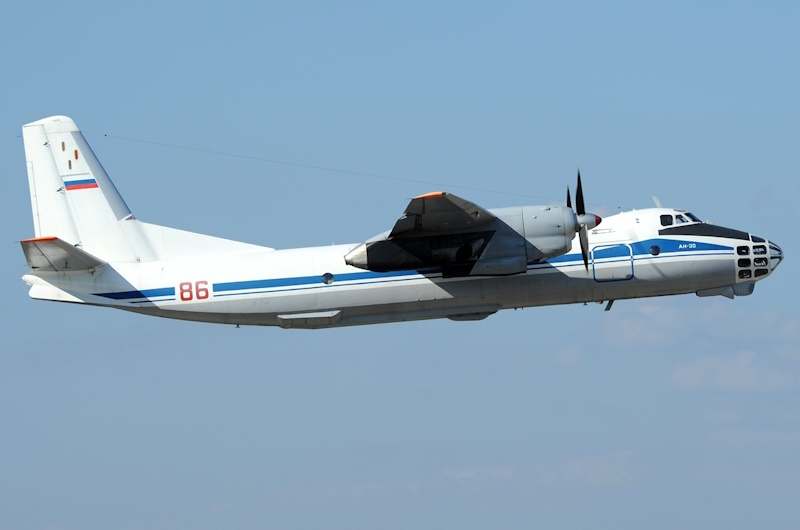
Access to the new glazed nose, nicknamed the "veranda", was through a cramped crawlspace. The glazed nose meant the elimination of radar, though a small Doppler groundspeed radar was fitted. The lack of a true radar was later seen as regrettable, and so some An-30s were fitted with a Groza-M30 radar in a fairing under the nose, with the rear of the fairing being part of the nose landing gear doors. In most other respects, the An-30 was similar to the An-24 and could even be fitted with the external stores racks, though it never was in practice.
___________________________________________________________________
ANTONOV AN-30:
___________________________________________________________________
wingspan:
29.2 meters (95 feet 10 inches)
wing area:
74.98 sq_meters (807.1 sq_feet)
length:
24.26 meters (79 feet 7 inches)
height:
8.32 meters (27 feet 4 inches)
empty weight:
15,590 kilograms (34,370 pounds)
MTO weight:
23,000 kilograms (50,700 pounds)
cruise speed:
430 KPH (265 MPH / 230 KT)
service ceiling:
8,300 meters (18,300 feet)
range:
2,630 kilometers (1,635 MI / 1,420 NMI)
___________________________________________________________________
* A total of 65 An-30s was built for Aeroflot, with six more built for other Soviet civil organizations and 18 built for export. China was the biggest export user, obtaining at least seven machines. Other users included Afghanistan, Bulgaria, Czechoslovakia, Mongolia, Romania, Vietnam, and reportedly a few African countries.
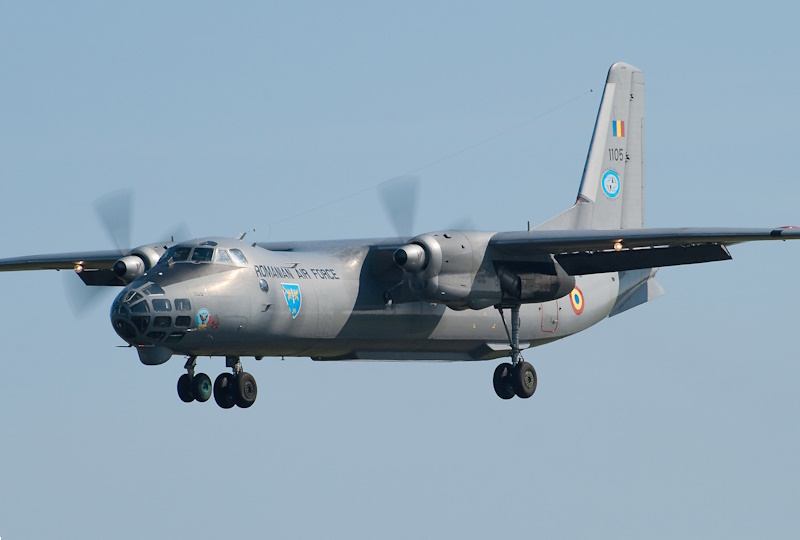
26 "An-30Bs" were built for the VVS, differing primarily from the civil An-30 in military avionics fit, including chaff-flare dispensers for self-defense. A handful of An-30Bs were used in the Afghan conflict to complement mainline military reconnaissance assets. Some military An-30Bs featured special reconnaissance equipment fits, including SLAR, TV cameras, and infrared line scanners, and there were also a few cases of civil An-30s being fitted with advanced surveillance gear for survey purposes. There were a number of specialized variants as well:
After the fall of the USSR, two An-30s were even converted into 20-seat "An-30-100" VIP transports -- a role in which the specialized features of the An-30 were absolutely irrelevant. This puzzling exercise was apparently performed simply because they were handy airframes that would otherwise have been mothballed or scrapped. Four An-30Bs were modified for surveillance as part of the "Open Skies" arms inspection program; details are scarce, and Open Skies was abandoned due to Russian non-cooperation anyway. A handful of An-30s were also used for test, trials, and research purposes, though details are scarce.
* In the mid-1970s, the Indian military issued a requirement for a new medium cargo aircraft. The An-26 generally fit the bill, but it lacked the needed performance, particularly under the "hot & high" conditions presented by the mountains of India's northern borders. However, Antonov OKB engineers felt that they could provide a solution by re-engining the An-26 with Ivchenko AI-20D turboprops, providing a whopping 3,865 kW (5,180 EHP) each -- 85% more than the AI-24VT engines used on the An-26. Power was not going to a problem with the new powerplants, and so the Indians were intrigued with the "An-32", as the proposal was designated.
An early-production An-26 was converted as the An-32 prototype, performing its first flight on 9 July 1976. The prototype was displayed at the Paris Air Show in 1977, with NATO assigning the type the reporting name "Cline". Two pre-production prototypes followed, with the An-32 going into production at the Kyiv factory in 1980. The initial idea had been for Hindustan Aeronautics Limited (HAL) to license-build the An-32 in India, but that scheme fell through.
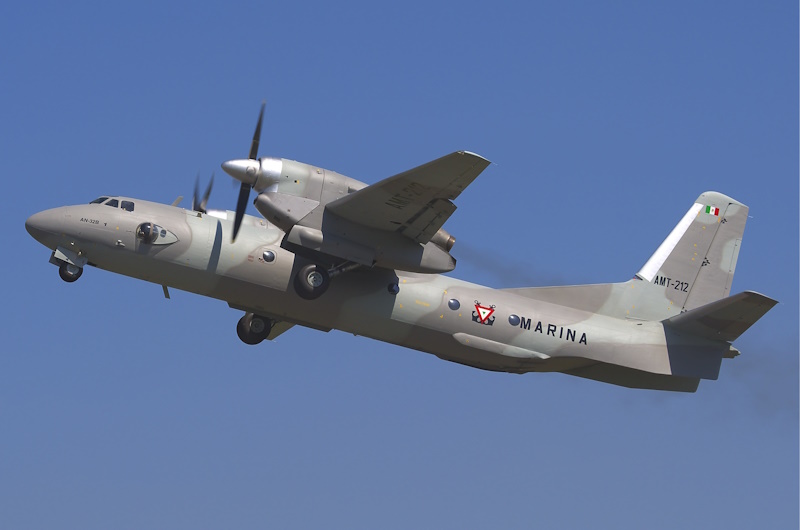
* The An-32 featured the AI-20D turboprops mounted in nacelles that placed the engines above the wings, not forward of them as with the An-26. That was done partly because the AI-20Ds were substantially bigger, affecting the aircraft center of gravity, and partly because they used wider-span four-bladed props -- increased from 4.5 meters (14 feet 9 inches) in diameter to 4.7 meters (15 feet 5 inches) in diameter -- leading to a ground clearance problem. The increase in engine power and the repositioning of the engines of course had a series of "follow-on" effects that demanded a few other changes in the aircraft design:
In addition, although the An-26 used single-piece inboard flaps instead of the double slotted flaps originally used on the An-24, the An-32 was intended for "hot & high" operation, and so the fit of triple slotted flaps was seen as worthwhile. While the exhausts of the engines on the An-32 prototype had been initially positioned at midwing, they were later extended to behind the wing trailing edge, with production machines retaining this configuration. It is unclear why this change was made, but at the very least extending the exhausts eliminated the nasty streak of soot on the wing behind the engines found on the early prototype configuration. The prototype also initially featured a fixed slot on the bottom leading edge of the tailplanes that was supposed to help de-icing by altering airflow, but the decision was made that it was more bother than it was worth, and hot-air de-icing was reinstated.
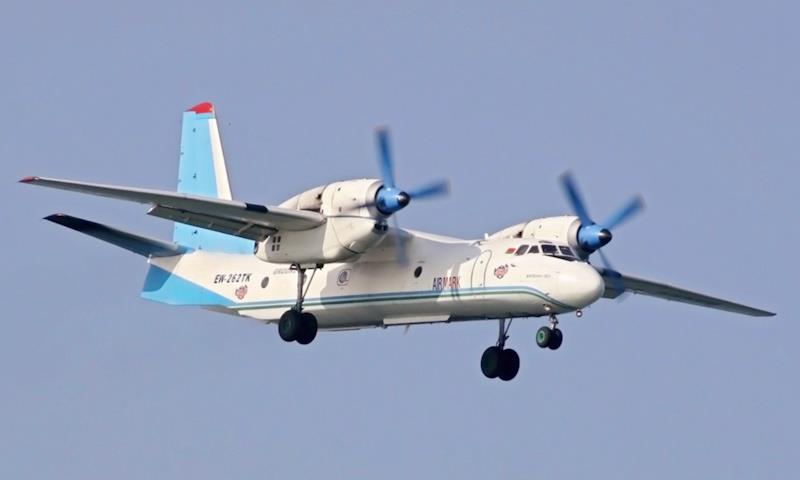
Improved avionics were fitted; the additional thrust provided by the RU19A-1900 APU/booster was no longer important, so the An-32 reverted to the TG-16 APU. Cargo-handling gear was like that of the AN-26, and the side observation dome with bombsight was retained as well, as was the capability of carrying external cargoes.
___________________________________________________________________
ANTONOV AN-32:
___________________________________________________________________
wingspan:
29.2 meters (95 feet 10 inches)
wing area:
74.98 sq_meters (807.1 sq_feet)
length:
23.78 meters (78 feet)
height:
8.75 meters (28 feet 9 inches)
empty weight:
16,800 kilograms (37,040 pounds)
MTO weight:
27,000 kilograms (59,525 pounds)
cruise speed:
470 KPH (290 MPH / 255 KT)
service ceiling:
9,500 meters (31,170 feet)
range (max fuel):
2,500 kilometers (1,555 MI / 1,350 NMI)
range (max load):
2,000 kilometers (1,245 MI / 1,070 NMI)
___________________________________________________________________
* The high-mounted engines of the An-32 gave the aircraft a distinctly "muscular" look, which was not deceiving: everybody who operated it was impressed by how much power it had, even under a full load and "hot & high" operating conditions. In 1985, to no surprise, an An-32 set over a dozen altitude and performance records in its class -- one suspects it had an impressive rate of climb in unladen configuration. The An-32 was also, as was the case with the best Soviet gear, very rugged and reliable.
A total of 214 was built for export up to 1994, with India being the biggest user at 123 aircraft, the first Indian An-32 being delivered in the summer of 1984. The Indians have been very fond of the An-32, contracting with Antonov in 2009 to upgrade 105 machines to the "An-32RE" configuration with modern avionics, a new oxygen system, and improved crew seats. 40 were upgraded in Ukraine, the rest domestically with Ukrainian assistance.
Afghanistan was the second-biggest An-32 user at 49 aircraft. There were about a dozen or so more users, including Angola, Bangladesh, Colombia, Croatia, Ethiopia, Mexico, Nicaragua, Panama, Peru, Saudi Arabia, Tunisia, Swaziland, and possibly a few others. Users with high mountain terrain like Peru found the An-32 particularly useful. Two of the Mexican An-32s were apparently fitted with a quick-change equipment suite by the Heli-Dyne company of the US for operation in the maritime patrol role. There are also vague tales of a few An-32s operated by the US Special Operations Command (SOCOM).
The Soviet military had no particular interest in the unique capabilities of the An-32 until the very last days of the USSR, finally ordering a batch of almost 50 for special operations. Some of these machines were built with downrated AI-20M engines providing 3,170 kW (4,250 EHP), the maximum power of the AI-20D being seen as less attractive than extending engine life and lowering fuel consumption. The production of these machines overlapped the collapse of the Soviet Union and they never went into Russian service, instead being sold off on the export market.
However, from the late 1980s about three dozen civilianized "An-32A" machines -- very much like the baseline An-32, but with civil avionics -- were built for domestic civil organizations. They were followed in the mid-1990s by the "An-32B", which featured general small refinements, with about 40 built, mostly for domestic use -- though a few ended up in North Korean hands by a sneaky "back door" process. Six were sold to Iraq in 2009, with at least two of these machines altered to a bomber configuration, able to carry four Chinese-made 225-kilogram (500-pound) pounds. One featured a roll-off carrier in the cargo bay, dropping bombs out the cargo door, while another feature two stores pylons along each side of the fuselage. They have been used in attacks on Islamic State (IS) insurgents.
The Antonov organization also designed a further improved "An-32B-100" cargolifter and "An-32V-200" tactical transport, with various updates such as fuselage reinforcements, new engines, and modernized avionics, it appears mostly for the export market.
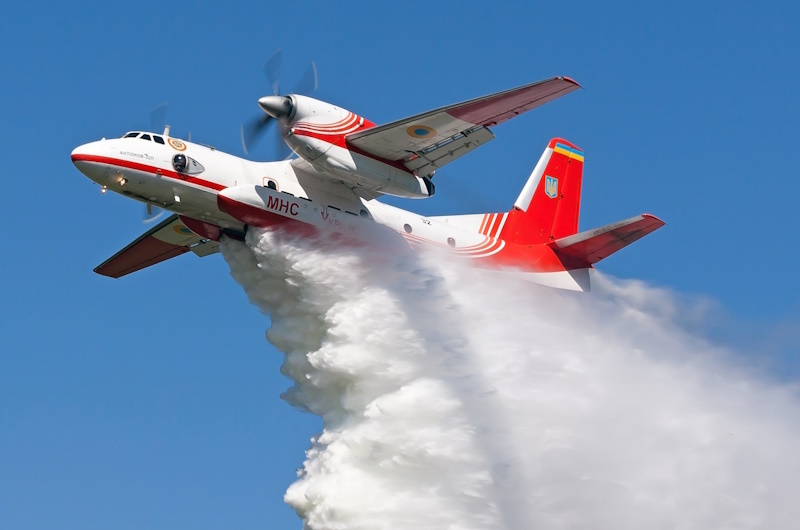
There have been a number of special conversions of the An-32. In the early 1990s, two were converted as demonstrators for an "An-32P" fire-fighting configuration, featuring a large tank for fire retardant mounted externally on each side of the lower fuselage. At least three were built, to end up flying in Ukrainian service, being used as cargolifters outside of fire season. A few An-32 testbeds, including one to evaluate new eight-bladed "propfan" propellers, have been flown, and proposals have been offered for special variants such as a maritime patrol configuration.
* In 2015, Antonov signed a deal with Taqnia Aeronautics Company of Saudi Arabia for co-production of a refined An-32, the "An-132D". Initial flight of a prototype was on 31 March 2017. The An-132D was powered by Pratt & Whitney Canada PW150A turboprops -- with 3,780 kW (5,070 SHP) each -- driving Dowty propellers, replacing the Ivchenko engines. It also had updated avionics, including a Honeywell glass cockpit. Only one prototype had been completed when the Saudis pulled out of the project in 2019, and that was the end of the program. The prototype was effectively destroyed during the fighting for the Antonov Airport near Kyiv in 2022.
BACK_TO_TOP* In 1993, the Antonov organization announced development of a successor to the An-24, the "An-140" -- a twin-turboprop machine with a general configuration like that of the An-24. The first An-140 prototype performed its initial flight on 17 September 1997, with a second prototype flying in 1998 and the first production machine flying on 11 October 1999.
The An-140 had a general configuration much like that of the An-24, to the extent that someone with no strong familiarity with aircraft might confuse the two. The An-140 was obviously a new design aircraft, however, sharing little with the An-24 but configuration, and also somewhat smaller. It was made mostly of aircraft aluminum, with some use of titanium. It had a high straight wing and swept tail surfaces of conventional arrangement -- though the tailplanes had a noticeable dihedral.
The An-140 was powered by twin Motor Sich AI-30 turboprops -- Klimov TVS-117VMA-SBM1 engines, license-built in Ukraine -- driving six-bladed fully reversible "scimitar" props. A Motor Sich AI-9-3B APU was fitted in the extreme tail. The An-140 had tricycle landing gear, all gear with twin wheels, the steerable nose gear retracting forward, the main gear retracting into sponsons. There were no main gear doors, the wheels remaining visible after being retracted.

The An-140 had a flight crew of two, plus a cabin attendant; avionics were as normal for a commercial airliner, including a Buran A-140 weather radar in the nose. It had a traditional "analogue" cockpit layout, to reduce cost. The An-140 was pressurized and climate conditioned; it was typically arranged with 52 seats, with a fold-down airstair passenger door on the left rear fuselage, matched by a service door on the right rear fuselage, plus an emergency exit on the left front fuselage, matched by a large cargo loading door on the right front fuselage. It also featured a galley, toilet, and coat closet in the rear. There were baggage compartments in the rear and under the forward floor. The forward floor was reinforced and the An-140 could be used in "combi" arrangements.
___________________________________________________________________
ANTONOV AN-140:
___________________________________________________________________
wingspan:
24.5 meters (80 feet 4 inches)
wing area:
74.98 sq_meters (807.1 sq_feet)
length:
22.6 meters (74 feet 2 inches)
height:
8.225 meters (27 feet)
empty weight:
10,600 kilograms (22,375 pounds)
MTO weight:
19,150 kilograms (43,220 pounds)
cruise speed:
575 KPH (355 MPH / 310 KT)
service ceiling:
9,500 meters (31,170 feet)
range:
2,100 kilometers (1,305 MI / 1,135 NMI)
___________________________________________________________________
The baseline An-140 was replaced in production in 2003 by the "An-140-100", which featured a 1-meter (39-inch) increase in wingspan, from 24.5 meters (80 feet 4 inches) to 25.5 meters (83 feet 8 inches) and maximum take-off weight raised from 19,150 kilograms (43,220 pounds) to 21,500 kilograms (47,400 pounds). Apparently Pratt & Whitney Canada PW127A turboprops were on offer as powerplants in place of the AI-30 turboprops, though it's not clear if anyone obtained them.
HESA of Iran obtained a license for construction of the An-140 at a plant in Esfahan, with the first "IrAn-140 Faraz" performing its initial flight in February 2001. Initial production was from Russian-supplied knockdown kits, the plan being to eventually move to more assemblies built locally. The last Ukraine-built An-140s were delivered in 2005, the last in HESA-built machines in 2017. Some were apparently built by Aviakor in Samara, Russia, but no details are available. It is also not clear how many An-140s were actually built -- no more than 33, it seems.
BACK_TO_TOP* The following list summarizes the major variants of the An-24 family:
* Sources include:
Several editions of JANE'S ALL THE WORLD AIRCRAFT were consulted for details, as well as manufacturer's press releases.
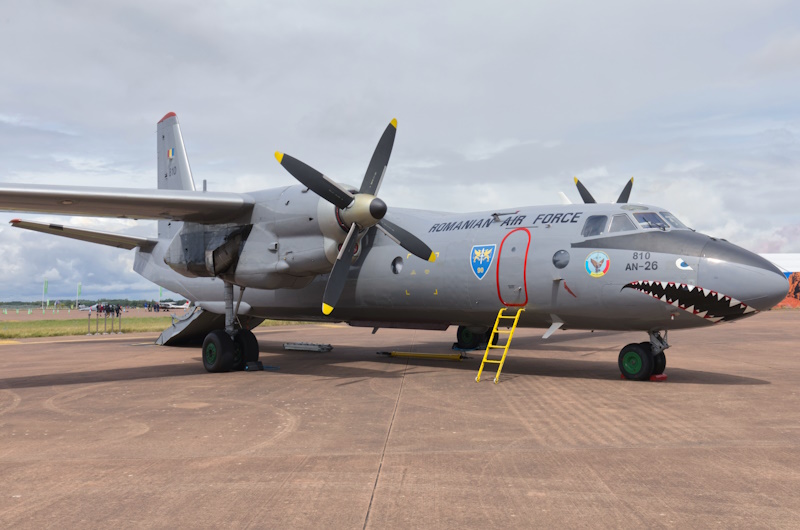
* Illustrations credits:
* Revision history:
v1.0.0 / 01 mar 10 v1.1.0 / 01 feb 12 / Added An-140, Split into two chapters. v1.1.1 / 01 jan 13 / Review & polish. v1.1.2 / 01 nov 14 / Review & polish. v1.1.3 / 01 oct 16 / Review & polish. v1.1.4 / 01 sep 18 / Review, update, & polish. v1.1.5 / 01 oct 22 / Review, update, & polish. v1.2.0 / 01 feb 25 / Illustrations update. (!)BACK_TO_TOP
